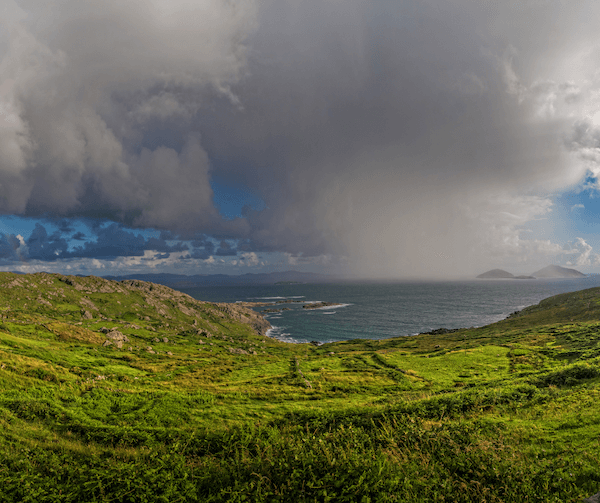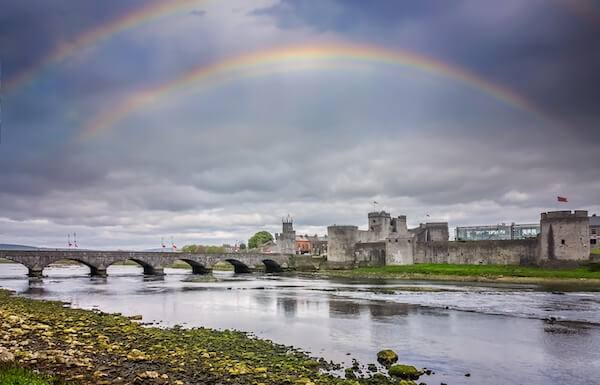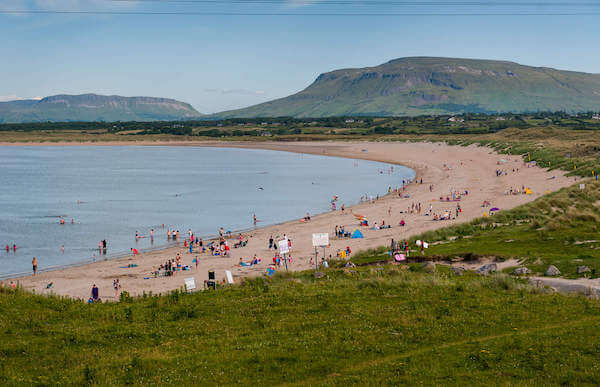Are you traveling to Ireland in the future? Are you concerned about Ireland’s weather given its changeable nature?
 This blog post contains affiliate links, and I may earn compensation when you click on the links at no additional cost to you.
This blog post contains affiliate links, and I may earn compensation when you click on the links at no additional cost to you.
It’s true. It does indeed rain a lot in Ireland but don’t let that put you off from visiting the Emerald Isle. After all, there’s a reason why Ireland is so green!
To get you prepared for your trip and for any possible weather conditions that might come your way no matter what time of year you visit, here’s some useful information to keep in mind.

- Book the best tours and guides on Tripadvisor, Viator or GetYourGuide
- Get reliable travel insurance with Travel Insurance Master
- Get the best flight tickets with Aviasales
- Rent a comfortable car via Discovercars
- Find the best accommodation on Booking.com or BandBIreland
What Affects Ireland’s Climate?
The North Atlantic Current helps to extend the Gulf Stream northeastward, which is then carried by the prevailing winds toward Ireland, resulting in its mild climate.
In fact, it is much milder than other regions that are on the same latitude, such as Canada’s Hudson Bay, Russia’s Kamchatka Peninsula, and Southern Alaska.
The effects of the Gulf Stream have been known for centuries. During his time in London, Benjamin Franklin was curious as to why it took mail packets so long to get from London to America, while the opposite journey was much faster.

A Nantucket whaling captain explained to Franklin that because merchant ships were routinely crossing a current, identified by the behavior of whales in the Atlantic, the water's temperature and changes in its color, the mail transporters from England were going against it, and so Franklin decided to chart the journey of the stream.
Much more is now known about the Gulf Stream and its effects, including why Ireland gets so much rain because of it.

You see while it keeps the island relatively mild, it also brings with it plenty of moisture — and of course, rain clouds — and those clouds tend to break up over the west coast first, which is why Dublin is generally drier than, say, Galway.
Ireland’s total rainfall, however, is lower than other places in the U.S., for example.
Ireland's Average Temperatures by Month

According to records from Ireland’s meteorological service, Met Eireann, the average rainfall records for 2021 were lower than years previous, ranging from 666.7 millimeters (26.4 inches) at Dublin Airport to 1,725.6 millimeters (67 inches) at a weather station in Newport, Co. Mayo.
By contrast, the average rainfall in Tallahassee, Fl., is 58.7 inches, in Olympia, Wa., it’s 52.7 inches, and in Columbus, Ohio, it’s 39.7 inches.

The downpours that are common in regions of the United States, especially places where hot, humid weather is common, aren’t that frequent in Ireland since its rainfall comes in spurts that may last for short periods, with a burst of sunshine and blue skies shortly afterward.
Contrary to popular belief, it does not rain in Ireland all day. The intermittent rainfall, however, explains why Ireland can get 4 seasons all in one day!
By clicking on the Amazon link below, I may earn a small commission from the Amazon Associates Program, but only if you decide to buy something on the site. However, you will not incur any additional costs by doing so.
Grab the Guide to Carry-on Luggage for Your Next Trip to Ireland (or Anywhere!)
How to Prepare for Ireland’s Changeable Weather
The best advice I can give you is to bring a light jacket during the summer months and in the colder months, dress in layers as the dampness in Ireland is uncomfortable for many visitors who come from climates where cold temperatures feel drier.

However, dressing in layers during the warmer months is advisable too, especially if you are planning to hike or walk a lot or if you’re exploring the west coast where the wind can be quite strong.
The average temperatures in Ireland range from about 12 degrees Celsius (54°F) to 18 degrees Celsius (64.5°F).
Of course, that can go up or down depending on when you’re in Ireland, and there will be some days during the summer when it can get as warm as 20 or 25 degrees Celsius (close to 80°F), which is why, again, it’s difficult to predict.

Even if the sun is not splitting the rocks, you can still get sunburn in Ireland – yes, it’s true!
Because of the country’s northern latitude, the sun can be quite strong, with a UV index of 3 or above between the months of April and September.

This is why it is important to wear sunblock, preferably one that does not contain chemicals and provides adequate protection for your skin type.
By clicking on the Amazon link below, I may earn a small commission from the Amazon Associates Program, but only if you decide to buy something on the site. However, you will not incur any additional costs by doing so.
Dermatologists suggest wearing a sunscreen that is mineral-based and contains zinc oxide and titanium oxide, which is considered safe to use.
Best Time of Year to Visit Ireland for the Weather
It is difficult to pinpoint the best time to visit Ireland in terms of the weather given its changeable nature.

However, if you thrive better in milder temperatures and you’re the kind of tourist who loves to cram everything into a day, I’d suggest that summer is the best time to visit (realistically, any time between May and September).
At the height of summer, the days are incredibly long in Ireland (it’s still light until 10:30/11 p.m.), making driving less stressful and the fact that you can see more attractions while there is still daylight.
Be aware that prices are higher in Ireland during the summer and there are more crowds to popular attractions like The Cliffs of Moher, The Book of Kells, and others.

My recommendation is to visit during the shoulder season (mid-April to the end of May and again in late September through October).
The days will be shorter during the early spring and fall, but the weather can be surprisingly good and if you’re watching your budget, traveling to Ireland in the off-season is a good idea.
You’ll notice a definite chill in the air come October, and of course, the winter months (from November through March) will be the coldest.
Ireland rarely gets a lot of snow, but occasionally, the roads do get icy in the winter months.

